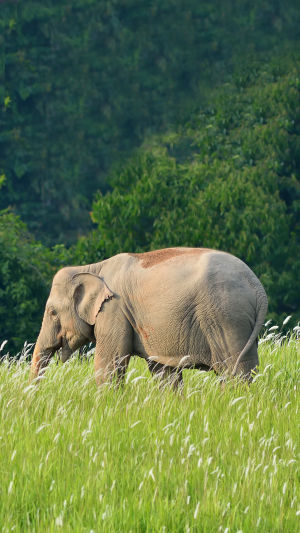Elephant populations around the world are known to be in decline due to factors such as illegal poaching and habitat loss. In the IUCN Red List of Threatened Species, the African Forest Elephant (Loxodonta cyclotis) is listed as Critically Endangered (CR).
And the African Savannah Elephant (Loxodonta africana) and Asian Elephant (Elephas maximus) are listed as Endangered (EN).
According to the assessment, the number of African forest elephants decreased by more than 86% between 1984 and 2015, while the number of African grassland elephants decreased by at least 60% between 1965 and 2015.
Given enough safe and healthy habitats, a wild African elephant can live for over 60 years! The establishment of World Elephant Day is to call attention to the urgent plight of African and Asian elephants. This article will take you to learn about the elephant.
African elephants live in a variety of habitats, from the deserts of Namibia to the forests of the Congo to the grasslands of Kenya and Tanzania.
The African savannah elephant is the largest terrestrial mammal on earth and the largest among the three elephant species in the world (African savannah elephant, African forest elephant, and Asian elephant).
Adult African elephants can be up to 24 feet (about 7 meters) long, 13 feet (about 4 meters) high and weigh 11 tons.
African elephants share deep family ties and live closely in matrilineal family groups. After the baby elephant is born, the whole family is responsible for raising and caring for it.
They are eating most of the day! Elephants are herbivorous animals that feed on grass, leaves, bark, fruit, and various plant foliage. It can eat more than 300 pounds (about 136 kilograms) of food in a day.
Elephants have small eyes compared to their bodies, but who needs big eyes when you have the largest brain in the land animal kingdom? For most of an elephant's life, the tusks continue to grow.
Despite an international ban on the sale of ivory, elephants continue to be poached due to the high illegal market demand for their ivory. Note: The tusks of both female and male African elephants are obvious (in contrast, only males of Asian elephants have tusks, and females have no exposed tusks).
Elephants spray water on their bodies with their trunks to cool down. They also use their noses as snorkels when wading into rivers. The African elephant has a very strong nose, with more than 40,000 muscles and tendons, and can lift more than 400 pounds (about 181 kilograms) of objects at a time.
The sensitive tip of the African elephant's trunk has two finger-like protrusions (note: African elephants have two "fingers" on their trunks, while Asian elephants have only one "finger") that can be used to "grasp" very small objects.
African elephants use their large ears to regulate body temperature and help them stay cool in the hot African climate. Their enhanced blood vessels allow the elephants to dissipate heat by transferring it to the air around them. This is a vital adaptation that helps them survive in such a hot environment.
Conservation of large contiguous lands is critical for migrating elephant herds. TNC is working with local partners to protect the vast, unbroken landscape. Protecting wildlife corridors means more habitat and more protection for African elephants.
Elephants have greatly contributed to maintaining the balance of the ecosystem and increasing the biodiversity of savannahs and forests. Not only can they adjust the distribution of vegetation, create open areas and trails, and dig water for other wildlife, but they can also disperse seeds!
In some areas, 30 per cent of all plants would not thrive without elephants. Humans and nature are a community of life, and humans and animals also share the same earth. The actual home of wild animals is in the wild, and the best way to protect them is to preserve their natural homes.





